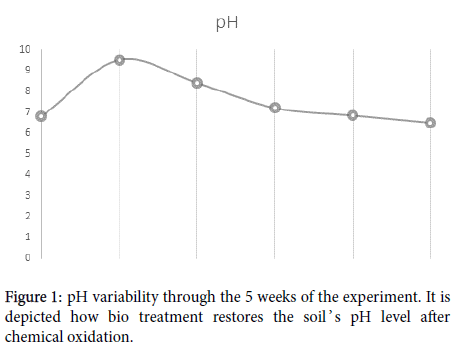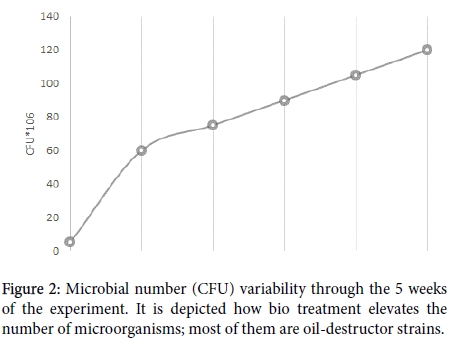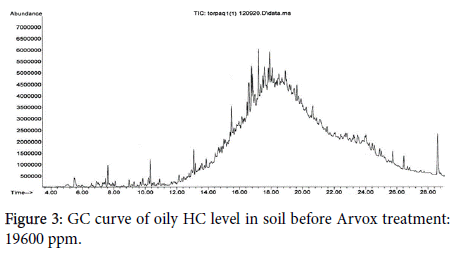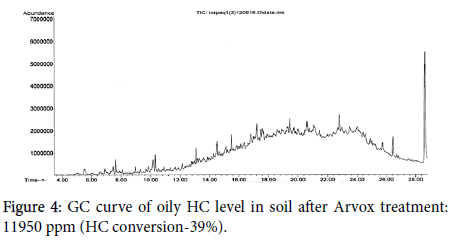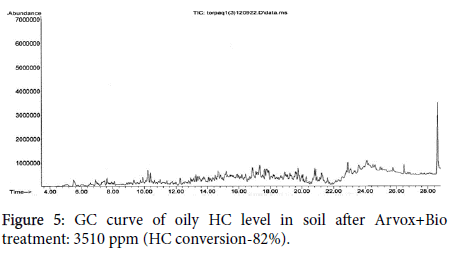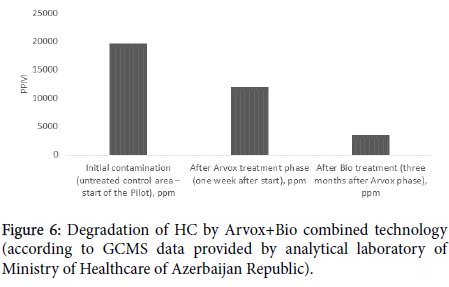The New Combined Chemical-Biological Remediation Method for Oil- Polluted Soils: Oxidative Disposal and Establishing Sustainable Soil Cenosis
Received: 15-Jul-2019 / Accepted Date: 31-Jul-2019 / Published Date: 07-Aug-2019
Abstract
Today, biological and oxidative methods are frequently used to remediate oil-contaminated soils. Both approaches have advantages and disadvantages in terms of speed, economy and environmental compatibility.
In the experiments carried out, an oxidation process was combined with a microbiological remediation approach. The petroleum hydrocarbons (PHC) were degraded much faster and more efficiently than in the individual applications. Within three months, 82% of the old PHC have been decomposed.
The soil was first treated with chemical oxidation, which destroyed 40% of the original PHC load in a short period of time. Subsequently a treatment with microorganisms took place, which provided for the further degradation.
In addition to removing pollutants, a significantly improved microflora was observed in the treated substrate, which is conducive to a sustainable restoration of the original soil.
The decontaminated soil can be used for agricultural purposes again within a short time.
Furthermore the method described provides a significant cost reduction compared with conventional treatment approaches.
Keywords: Oil-contaminated soils; Microbiological remediation; Microflora; Pollutants
Introduction
The rising demand for oil in the world economy leads to an increase in oil production. While the volume of daily oil demand in 2009 was 84.3 million barrels per day, by 2019 it will have risen to 100.6 million barrels [1]. The problem of soil pollution with oil and oil products is one of the most challenging and pressing both in developed and developing countries [2]. The cost for oil pollution disposal is high. For instance, in the US, the cost of 1 liter spilled oil disposal could be about $300 without taking into account any environmental impacts. Taking into account the environmental damage and the socio-economic consequences, the disposal price can reach $900 [3] per liter in order to fully minimize all impacts. Mechanical, physical, chemical and biological disposal methods are used to clean the soil from oil pollution. Combined methods are often applied to increase the speed of disposal and the efficiency of soil recovery. For example, the combined use of chemical and biological methods allows the rapid and effective removal of pollutants while restoring the physico-chemical composition and biological diversity of contaminated soil. Thus, the bioremediation of oil-polluted soils has found widespread application worldwide. Depending on the task, there are various approaches to the biological remediation of oil-contaminated soils: landfarming [4], composting [5], use of bioreactors [6,7], bioventing/biosparging [8,9], bioslurping [10], pump and treat strategy [11], biostimulation [12,13], bioaugmentation [14].
Biological remediation is recognised for its optimal environmental compatibility and is welcomed by regulatory authorities worldwide. Biological methods often are the first choice, especially when a recultivation of the contaminated soil is desired. They are more environmentally friendly than most approaches, deliver sustainable remediation results and create a balanced ecosystem. In many cases, however, the possibilities of bioremediation are limited: For example, if the pollutant is not bioavailable or if it is present in highly toxic concentrations.
If biological remediation as the only measure is not an option, the combination with a gentle chemical oxidation procedure is a promising approach. In the first stage, the most toxic pollutants are destroyed and at the same time the bioavailability of the remaining contaminants is increased. Subsequently, active microorganisms are used in the biological stage. These continue the degradation of the pollutants and enable a sustainable recultivation process that lasts without external influences. Where oxidation processes are applied in the first stage, the oxygen thus produced can be used by the aerobic flora, which adds an additional advantage to the biological stage. There are two known problems for such combined approaches: Biological methods are usually slow. In addition, a second treatment stage usually increased the costs. The desired solution is always a fast remediation at a moderate price.
The purpose of this study was to examine the combination of an oxidative and a biological process with regard to the factors efficiency, speed and economic viability. The product Arvox, developed and patented by the Swiss company Arva Greentech AG, was employed for the oxidative stage. Arvox is used on an industrial scale for the remediation of various soils and types of contamination. The underlying reaction is a hydrogen peroxide-based solution with catalysts and pH regulators. In the microbiological stage the products Fermenstart and Biomax of the Azerbaijani company AgriBioEkoTex were applied. The research provided is continuing in cooperation with several scientific institutions in Germany (Technical Universities of Berlin and Munich), Ukraine (V.N. Karazin Kharkiv National University) and Azerbaijan (A. Guliyev Institute of Chemistry of Additives, Azerbaijan National Academy of Science).
Materials and Methods
The Pilot test was carried out on the premises of the High Technologies Park (Baku, Azerbaijan) under supervision and with the participation of experts from the Institute of Soil Science and Agricultural Chemistry of the National Academy of Sciences of the Republic of Azerbaijan.
The experiment took place on an open field where two areas of 1.5 m × 2.5 m were specially prepared. The soil of one test field was contaminated with aged petroleum hydrocarbons (PHC), the other served as a control area. The contaminant concentration was 2%, the contamination depth was 25 cm. Before starting treatment with the oxidising agent, samples were taken from the site according to the procedure [15] and the hydrocarbon composition was determined by gas chromatography FID. This method of analysis was applied to all samples. The pH value of the soil was measured at 6.8.
The oxidant was then evenly distributed on the test field and ploughed in mechanically. The reagent was re-applied immediately afterwards. After 7 days, samples were taken and the hydrocarbon composition was determined. The soil’s pH value after the oxidative treatment was 9.5.
At the next stage, the experimental site was bioremediated. Now, contaminated and Arvox-treated soil was mixed with straw (5%) and bio-compost (up to 20%) on each test site, and then Fermenstart reagent (added 1:100) was added to prepare the substrate for the introduction of bacteria. On the next step each test site was treated with an aqueous solution of Biomax reagent (ratio 1:100) containing active strains of microorganisms-biodestructors. The total amount of Biomax solution used in the experiment was 150 liters. The solution was applied once a week in equal amounts of 37.5 liters for 4 weeks. The experimental fields were plowed and moistened twice a week. The moisture content of the soil was maintained at 50% for 3 months. After that, samples were taken and the soil's hydrocarbon composition was determined by gas chromatography.
Results and Discussion
As described, the investigated remediation process is divided into a chemical and a microbiological stage.
In the first stage, the Arvox reagent enters a chemical oxidation reaction with the contaminant. The reaction itself occurs on the surface of the smallest (colloidal) soil particles. By oxidizing the contaminant, the Arvox reagent facilitates the work of microorganisms, which in the course of their activity in the second stage of the treatment train (bio stage) contribute to the accelerated degradation of oil and oil products.
During the experiment, the soil pH values were monitored. After oxidative pre-treatment, the pH value in the soil was 9.5, one week after the start of the bio stage it was 8.4, two weeks later 7.2 and one month later 6.5 (Figure 1).
The change in pH values during the test indicates physico-chemical processes taking place in the soil under the influence of the tested reagents. As a result of oxidation, a significant increase in the pH value can be observed. The use of bioreagents normalizes the pH value to the level usual for unpolluted soil systems. This indicates the restoration of physico-chemical parameters to the original level.
A significant elevation of total microbial number was observed during the experiment (Figure 2). An initial increase was observed after oxidative treatment, probably due to the rapid oxygenation of the soil and the increase in partially destroyed hydrocarbons, which immediately became much more bioavailable. The introduction of Fermenstart and Biomax lead to significant increase in microbial number, up to 1.4 × 108 CFU/g of the soil.
Together with pH normalization, these microbial indices speak for a sustainable remediation process in which the combination treatment very quickly produced biocenosis that promotes a continuous selfcleaning process of the soil until its complete recovery (Figure 3).
Such a result is important for large-scale use in commercial soil remediation, as chemical oxidation in many cases leads to soil degradation by salination [15]. These soils lost fertility after treatment, could no longer be cultivated and in the worst case had to be excavated and deposited. In view of the globally accepted concept of sustainable remediation, the disposal of pollutants is generally not the desired measure. The treatment technology should restore the soil to a condition that comes as close as possible to its natural ground state. The area treated in this experiment can therefore be seen as sustainably restored (Figures 4 and 5).
The product Biomax used in this experiment has proven to be suitable for further self-remediation of the treated soil. The preparation combines the active cenosis of aerobic and anaerobic pollutant destructor strains. This allows effective soil regeneration even without active aeration.
The use of chemical oxidation for the degradation of petroleum hydrocarbons significantly accelerates the remediation process. However, many chemical remediation approaches leave behind reaction products that can be more harmful to the environment than the original hydrocarbons.
Peroxide compounds under appropriate conditions do not lead to the occurrence of harmful by-products or produce them only in such small quantities that they are degraded during the subsequent biological treatment. The combined method obviously allows not only effective removal of pollutants, but also restoration of physicalchemical and biological parameters. This approach can significantly reduce the time and cost required to restore oil-contaminated soil.
As the experimental data show (Figure 6), the concentration of petroleum hydrocarbons in the treated soil has decreased as follows compared to the control area:
-39% after oxidative treatment;
-82% after the subsequent biological stage.
We assume that with repeated use of chemical oxidation the already high initial degradation of 39% could be further increased. As mentioned above, however, the excessive use of oxidation often leads to salination of the soil and contamination of the groundwater, as excess amounts of chemicals with peroxide and reaction water accumulate in the soil. In the case described, the bio-stage not only enables additional pollutant degradation, but also the removal of reaction residues in the soil system.
We conclude that chemical (oxidative) and biological remediation processes complement each other and increase the efficiency of the entire soil detoxification process.
Conclusions
• The joint (sequential) use of chemical oxidation with the product Arvox (developed by Arva Greentech AG) and bioremediation with the products Fermenstart and Biomax (developed by AgriBioEkoTex LLC) enables rapid and significant degradation of petroleum hydrocarbons in contaminated soils. In addition, the treatment restores the original soil quality, which would not be possible in the same period by using only one of the two methods.
• Under the influence of Arvox oxidative treatment hydrocarbon compounds are converted into biodegradable end products which rises their bioavailability, thus facilitates and accelerates their further mineralization.
• The combined approach, implemented in the experimental section of the High Technologies Park (Baku), demonstrated efficiency comparable to that described for laboratory experiments, thus confirming its accessibility for the real projects of soil rehabilitation.
• As mentioned above, the use of conventional remediation and disposal methods can produce costs of up to $300 per 1 liter of spilled oil. The combination of chemical oxidation and biological treatment tested here costs about $150-170 for the same case.
References
- Fingas M, Michel J (2016) Oil Spills: Causes, consequences, prevention, and countermeasures. Fossil Fuels USA. 1: 159-201.
- Genou G, De Naeyer F, Van Meenen P, Van der Wert H, De Nijis W, et al. (1994) Degradation of oil sludge by landfarming: A case study at Ghent Harbour. Biodegrad 5: 37-46
- Jorgensen KS, Puustinen J, Suortti AM (2000) Bioremediation of petroleum hydrocarboncontaminated soil by composting in biopiles. Environ Poll 107: 245-254.
- Daugulis AJ (2001) Two-phase partitioning bioreactors: A new technology platform for destroying xenobiotics. Trends in Biotechnol 19: 457-462.
- Liu CW, Liu HSÂ (2011) Rhodococcus erythropolis strain NTU-1 efficiently degrades and traps diesel and crude oil in batch and fed-batch bioreactors. Process Biochem 46: 202-209.
- Bulman TL, Newland M, Wester A (1993) In situ bioventing of a diesel fuel spill. Hydro Sci J 38: 297-308.
- Kittel JA, Hinchee RE, Hoeppel R, Miller R (1994) Results of a multi-site field treatability test for bioslurping: Acomparison of lnapl rates using vacuum-enhanced recovery (bioslurping),passive skimming, and pump drawdown recoverytechniques.
- Cheremisinoff NP (1998) Pump and treat remediation technology. In: Groundwater remediation and treatment technologies. William Andrew Applied Science Publishers, New Jersey.
- Delille D, Coulon F, Pelletier E (2004) Effects of temperature warming during a bioremediation study of natural and nutrient-amended hydrocarbon-contaminated sub-antarctic soils. Cold Region Sci Technol 40: 61-70.
- Evans FF, Rosando AS, Sebastian GV, Casella R, Machado PL, et al. (2004) Impact of oil contamination and biostimulation on the diversity of indigenous bacterial communities in soil microcosms. FEMS Microbiol Ecol 49: 295-305.
- Devinny J, Chang SH (2000) Bioaugmentation for soil bioremediation. In: Wise DL, Trantolo DJ (eds) Bioremediation of contaminated soils. Marcel Dekker Press, New York, USA, pp: 465-488.
- Nekhoroshkov P, Kravtsova A, Kamnev A, Bun’kova O, Duliu O, et al. (2017) Assessment of minor and trace elements in aquatic macrophytes, soils and bottom sediments collected along different water objects in the black sea coastal zone by using neutron activation analysis.
- Gawel LJ (2006) A guide for remediation of salt/hydrocarbon impacted soil.
Citation: Babayev ER, Ali-zade AM, Babayev VA, Harkavenko VV, Seryy SS (2019) The New Combined Chemical-Biological Remediation Method for Oil-Polluted Soils: Oxidative Disposal and Establishing Sustainable Soil Cenosis. J Bioremediat Biodegrad 10: 464.
Copyright: © 2019 Babayev E, et al. This is an open-access article distributed under the terms of the Creative Commons Attribution License, which permits unrestricted use, distribution, and reproduction in any medium, provided the original author and source are credited.
Share This Article
Recommended Journals
Open Access Journals
Article Usage
- Total views: 2815
- [From(publication date): 0-2019 - Feb 22, 2025]
- Breakdown by view type
- HTML page views: 2175
- PDF downloads: 640

